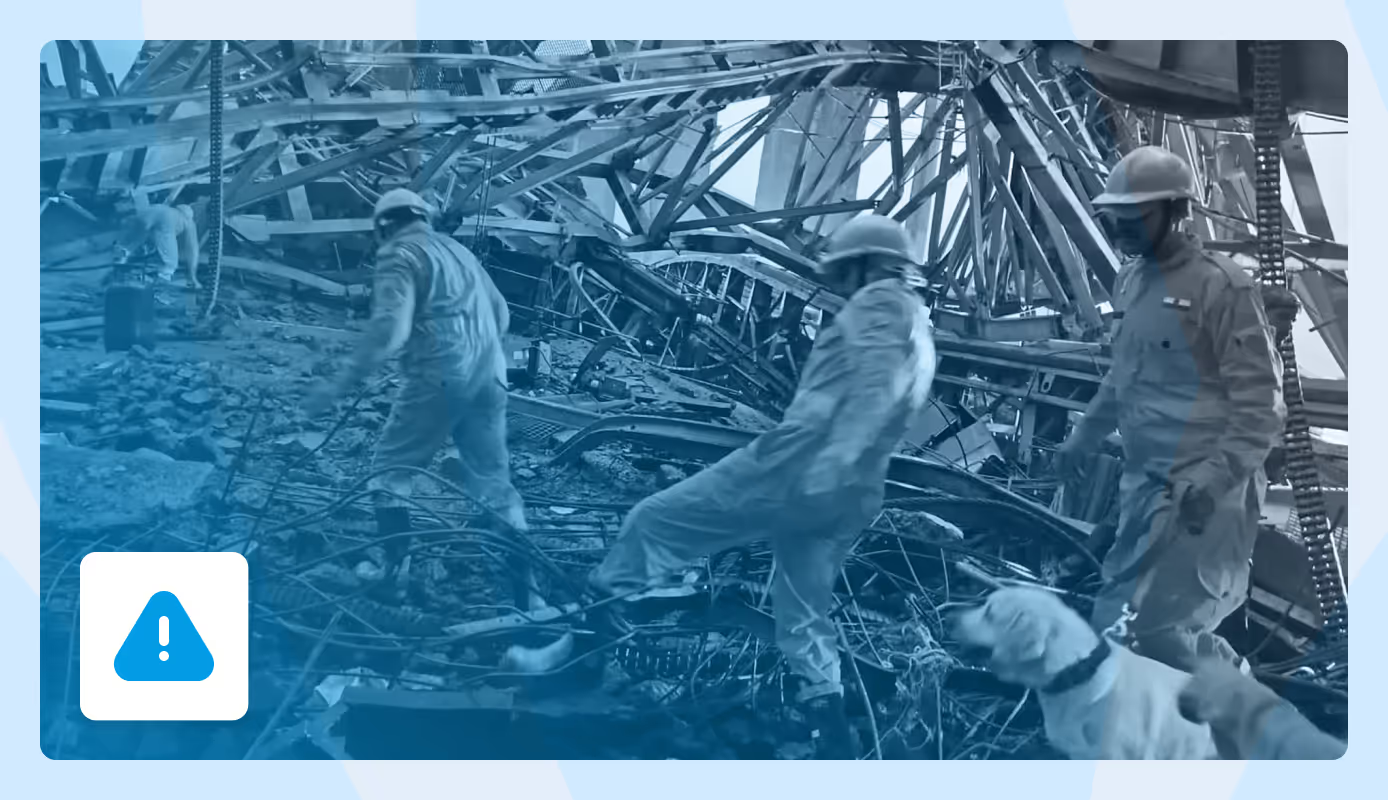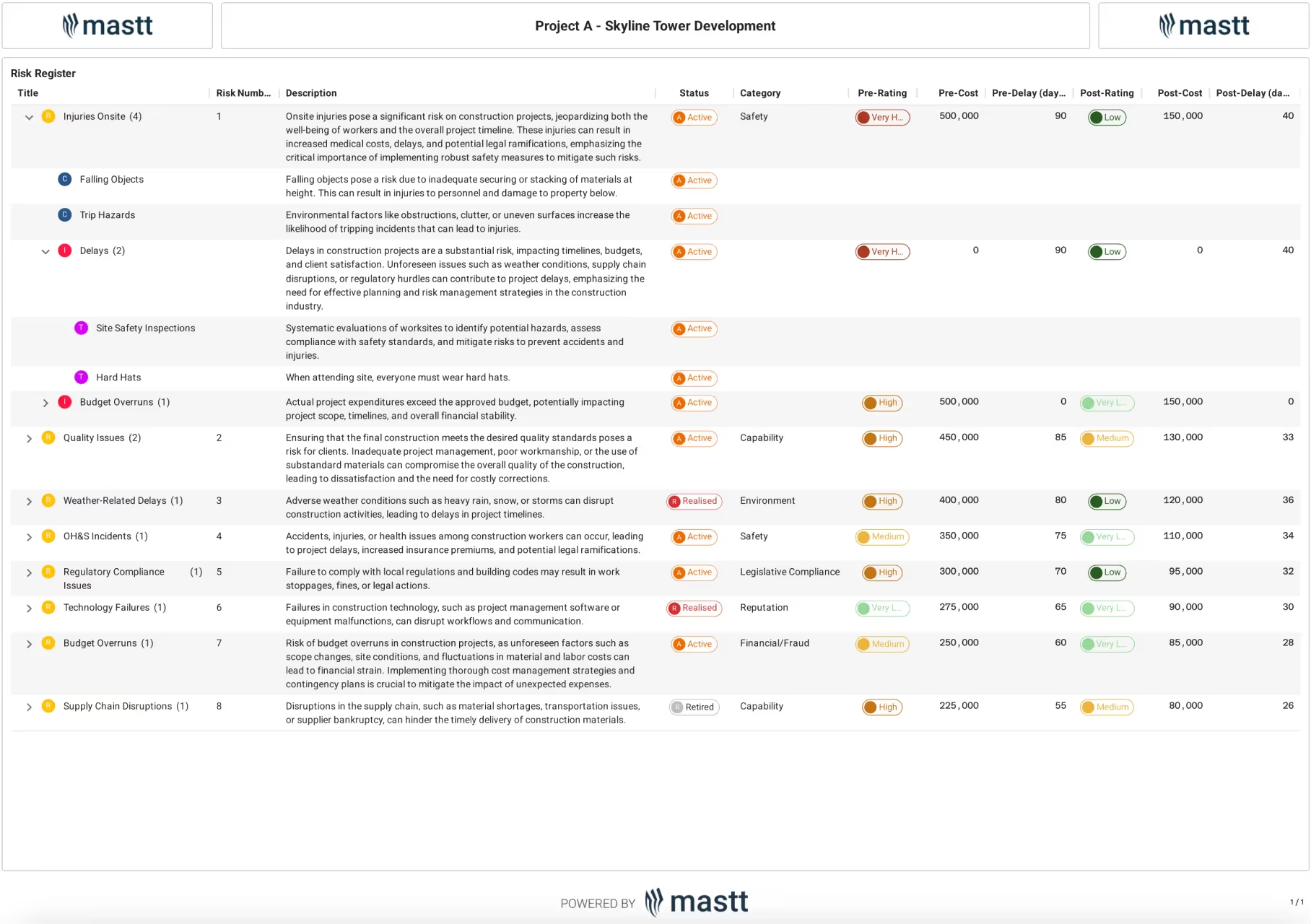Construction sites are hazardous due to height, heavy machinery, and constantly changing conditions. Each year, at least 60,000 fatal accidents occur on construction sites globally. This accounts for roughly one in six work-related deaths, according to the International Labour Organization's data on construction safety.
This article outlines top construction accidents and their causes, along with key strategies to prevent them.
1. Falls from Heights
Falls from heights and elevated surfaces are the leading cause of construction fatalities. They tragically account for approximately one-third of all deaths in the industry. These fall accidents typically occur when a construction worker falls from roofs, scaffolding, ladders, or other elevated platforms.
What Causes Falls on Construction Sites
❌ Missing or inadequate fall protection systems
❌ Improper use of safety harnesses and lanyards
❌ Unstable or improperly secured scaffolding
❌ Holes in floors or roofs without proper covers
❌ Weather conditions affecting surface stability
How to Prevent Falls on Site
✅ Implement comprehensive fall protection systems
✅ Train all workers to use harnesses and fall protection gear properly
✅ Conduct regular inspections of scaffolding and elevated work platforms
✅ Use hole covers and warning signs around floor openings
✅ Establish safety protocols for working in adverse weather conditions
Real‑World Example: Macquarie Park Fall Injury, April 2025
A Yahoo News report on a serious fall incident described a workplace accident in Macquarie Park, Sydney. On April 14, 2025, a man fell three meters through a void in a construction deck.
He was impaled on a wooden stake and seriously injured. Emergency crews winched him free and rushed him to the hospital. The case reinforces the need for secured floor openings, physical barriers, and fall protection systems on elevated platforms to prevent construction work injuries.
2. Struck by Objects
Being struck by falling, flying, or swinging objects accounts for about 10% of construction-related fatal injuries. These struck-by-object incidents happen when tools, materials, or equipment fall from a height. They can also occur when construction equipment moves or ejects objects suddenly.
Why Struck-By Accidents Happen on Site
❌ Poor housekeeping and disorganized storage areas
❌ Tools and materials left unsecured at height
❌ Lack of barriers or exclusion zones under overhead work
❌ Improper use or failure of heavy equipment
❌ Workers not wearing proper personal protective equipment (PPE)
How to Reduce Struck-By Hazards
✅ Require hard hats in all active work zones
✅ Use tool lanyards and secure small items in containers
✅ Mark and enforce exclusion zones below elevated tasks
✅ Maintain clear, clean walkways and store tools safely
✅ Install debris nets and protective canopies where needed
Real-World Example: Excavator Fatality in Michigan, June 2025
A news story on a struck-by incident in Brighton Township described a fatal event involving an excavator. On June 30, 2025, a 23-year-old road worker was struck and killed by an excavator bucket. He was standing in a trench when the operator, unaware of his presence, moved the machinery.
The impact caused a catastrophic injury before medical help could arrive. The case highlights the importance of communication, visibility, and spotters when operating heavy equipment near ground crews.
3. Electrocutions
Electrical hazards cause about 8% of construction-related fatalities. This kind of accident remains the fourth leading cause of death on construction sites. Most construction electrocution incidents happen when workers contact live circuits or energized equipment.
Why Electrocution Incidents Happen on Site
❌ Contact with overhead power lines during lifting or transport
❌ Faulty wiring or damaged electrical equipment
❌ Working on live circuits without lockout/tagout procedures
❌ Wet jobsite conditions during electrical tasks
❌ Missing or poor grounding and bonding systems
Electrical Safety Practices That Save Lives
✅ Apply lockout/tagout rules before starting electrical work
✅ Maintain at least 10 feet of clearance from power lines under 50kV
✅ Use ground-fault circuit interrupters (GFCIs) on temporary wiring
✅ Train workers in electrical safety and supply proper PPE
✅ Inspect electrical tools and cords before every use
Real-World Example: Falling Power Line Electrocution, June 2025
A news report on a Livingston County electrocution described a serious construction incident on June 5, 2025. Two construction workers were pouring concrete when a boom struck an overhead line. The power line snapped, causing a severe injury to both workers through electrical contact.
Authorities cited the lack of line markings and poor equipment clearance. The event reinforces the need for electrical planning and safety measures near energized utilities on construction sites.
4. Caught-in / Between Accidents
Caught-in or caught-between construction injuries occur when workers are trapped between objects, machinery, or engulfed by material. These trench collapse and equipment entrapment accidents often occur during excavation when unstable soil causes trench walls to collapse.
Why Caught-In/Between Injuries Happen
❌ Unprotected trenches or improperly sloped excavation walls
❌ Machines without guards or emergency shut-off systems
❌ Incomplete lockout/tagout during repairs or servicing
❌ Collapsing soil due to wet or unstable ground
❌ Workers positioned between moving vehicles or equipment
Safe Work Practices to Prevent Entrapment
✅ Use trench boxes or shoring for any excavation deeper than 5 feet
✅ Equip machinery with proper guards and emergency stops
✅ Apply lockout/tagout steps before servicing equipment
✅ Train competent persons to monitor excavation work daily
✅ Inspect soil, trench walls, and protective systems before each shift
Real‑World Example: Trench Collapse Rescue Incident, Toronto 2025
A CBC News account of a trench entrapment rescue described two workers trapped in an excavation in Toronto. On May 8, 2025, soil collapsed into a trench and buried both workers up to chest level.
Rescuers arrived quickly and freed the workers using monitoring gear and trench safety equipment. The incident illustrates the hazards of trench collapse in urban construction zones. Authorities reinforced the need for proper trench support and constant site monitoring to prevent a construction site injury.
5. Scaffolding Accidents
Scaffolding-related construction accidents involve scaffold collapse, falls from scaffolds, or workers being struck by falling scaffold components. These scaffold collapses often result from poor assembly, overloading, or damaged components used on-site.
Why Scaffold Collapses Happen
❌ Improper scaffold assembly or setup by unqualified workers
❌ Overloading platforms beyond their rated weight limit
❌ Using worn, broken, or incompatible scaffold parts
❌ Weak or uneven foundation beneath scaffold bases
❌ Missing guardrails or fall protection systems
Scaffold Safety Practices for Construction Sites
✅ Only trained personnel should erect and dismantle scaffolds
✅ Inspect scaffolds daily for damage, movement, or missing parts
✅ Follow the manufacturer's load limits at all times
✅ Require fall protection when working at height
✅ Maintain and repair scaffolds according to specifications
Real‑World Example: Port Arthur LNG Scaffolding Collapse, April 2025
A news report on the Port Arthur LNG scaffold failure described a tragic collapse on April 29, 2025. Three construction workers died and two others suffered injuries when a tank jump-form scaffold gave way at elevation.
Emergency teams halted all work immediately and initiated an OSHA investigation. This case highlights the dangers of elevated scaffolding failure and weak structural integrity. It reinforces the need for qualified assembly, rigorous load testing, and constant oversight during high-risk operations.
6. Machinery-Related Injuries
Heavy construction equipment, including excavators, cranes, bulldozers, and other machinery, causes numerous injuries and fatalities each year. These machinery-related construction accidents often occur when workers are struck by moving equipment or caught in the equipment's operational area.
Why Heavy Equipment Injuries Happen on Construction Sites
❌ Poor visibility during equipment operation
❌ Operators lacking proper training or licensing
❌ Missing or unqualified spotters near moving machinery
❌ No exclusion zones around active equipment
❌ Mechanical failure due to neglected maintenance
Safe Operating Practices for Heavy Machinery
✅ Provide certified training for all equipment operators
✅ Use spotters for tasks with a limited line of sight
✅ Mark and enforce exclusion zones around equipment
✅ Require all workers to wear high-visibility clothing
✅ Inspect and maintain machinery on a scheduled basis
Real‑World Example: North Phoenix Water Truck Rollover, Jan 2025
A news story on a water truck rollover described a fatal machinery rollover incident in North Phoenix. On January 4, 2025, an 18‑year‑old construction worker died after being thrown from a water truck during a downhill descent.
Investigators reported that the truck lost control and rolled over. The young worker was ejected and suffered fatal injuries. This case highlights risks during vehicle operation on slopes and stresses the need for safe vehicle control protocols.
7. Ladder Accidents
Ladder-related accidents on construction sites result from falls due to improper setup, equipment failure, or unsafe use practices. These ladder fall injuries are common because ladders are frequently used throughout construction projects.
Why Ladder Fall Injuries Happen on Construction Sites
❌ Ladders set at incorrect angles or not secured properly
❌ Using a ladder not designed for the specific task
❌ Overreaching or leaning while elevated
❌ Climbing on broken or worn ladder equipment
❌ Placing ladders on soft, sloped, or unstable ground
Safe Ladder Use Practices for Construction Work
✅ Follow the 4:1 ladder angle rule for stability
✅ Maintain three points of contact when climbing or descending
✅ Match the ladder type to the task and height needed
✅ Inspect ladder condition before every use
✅ Anchor ladder tops and stabilize the base before climbing
Real‑World Example: 15‑Foot Ladder Fall, St. Augustine 2025
A news article on a serious ladder fall incident described a worker injured while using a 15-foot ladder at St. Augustine City Hall. On June 20, 2025, the worker fell from a height while performing maintenance work. He sustained critical injuries and was transported to the hospital.
Firefighters noted that no harness or ladder stabilization was used. The case emphasizes the dangers of unsecured ladder use and the need for fall protection and ladder anchoring protocols.
Core Safety Practices to Prevent Construction Site Injuries
Core safety practices that prevent construction site injuries include training, PPE use, and inspections. These strategies apply across all types of common construction site accidents and can significantly reduce the risk of injury or death.
The following are the five essential practices that every construction site should implement to improve safety:
- Comprehensive Training: Equip construction workers with job-specific training, orientation, toolbox talks, and regular safety refreshers.
- Proper PPE Usage: Match protective gear to hazards, inspect regularly, and ensure consistent use across all construction work tasks.
- Regular Site Inspections: Perform daily checks to identify potential hazards early and document all corrective actions taken.
- Clear Communication: Leverage project meetings, signage, and open reporting to ensure everyone understands protocols and risks.
- OSHA Compliance: Stay current with occupational safety standards, maintain documentation, and update practices as regulations evolve.
Prioritizing these core safety strategies builds trust, accountability, and confidence. A proactive culture not only protects against construction injuries but also prevents construction worker deaths, strengthens performance, and enhances workforce resilience.
Final Thoughts on Preventing Construction Site Injuries
Preventing accidents on a construction site starts with awareness and consistent action. Knowing the common construction accidents is just the beginning. What matters most is how consistently your team applies safety practices like proper training, inspections, and protective equipment use.
Take time to review your current construction safety practices and identify any gaps in training, inspections, or hazard controls. Start conversations with your team, share this guide, and reinforce expectations with clear follow-through. Every effort you make today helps ensure that every worker goes home safely tomorrow.














